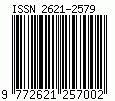Digital Identities and Aesthetic Expression: Uncovering Young Indonesians Argumentation in Filter Usage on Social Media
DOI:
https://doi.org/10.12928/channel.v12i1.724Keywords:
filters usage, Instagram, social media, digital identity, digital expression, youth cultureAbstract
This study delves into the diverse motivations and impacts of Instagram filter usage among young Indonesians, focusing on how these digital tools influence selfrepresentation and social interaction within the digital sphere. While Instagram filters are traditionally viewed as aesthetic enhancements, this research highlights their broader roles, including entertainment, education, and personal branding. Utilizing a qualitative approach, this paper collects data through interviews and netnography, employing snowball sampling to gather in-depth insights from eight young Instagram users. Findings indicate that young people use filters not only for visual enhancement but also for fun, educational engagement, and the expression of personal traits like humor and intelligence. This usage underscores young people's agency as active consumers, manipulating digital tools to craft their public personas and navigate social media spaces. This study underscores the need for further quantitative research to explore the widespread patterns of filter consumption among youth, aiming to enrich the understanding of digital identity formation in a globalized context.
References
Ali, A., Khan, N. A., Wang, H., & Wang, N. (2024). Investigating the Influence of Social Media on Employee Creativity: A Perspective from Social Network Ties. Creativity Research Journal, 36(1), 70–88. https://doi.org/10.1080/10400419.2022.2102753
Amelia, S., & Wibowo, A. A. (2023). Exploring Online-to-Offline Friendships: A Netnographic Study of Interpersonal Communication, Trust, and Privacy in Online Social Networks. CHANNEL: Jurnal Komunikasi, 11(1), 1–10.
Andrew, K. (2013). Przybylski, Kou Murayama, Cody R. DeHaan, Valerie Gladwell. Motivational, emotional, and behavioral correlates of fear of missing out. Computers in Human Behavior.-2013-07-01, 29(4).
Ar-Ridho, A., Rubino, R., & Madya, E. B. (2023). Navigating Digital Frontiers: Analyzing the Strategies and Impact of Islamic Da’wah on Instagram. CHANNEL: Jurnal Komunikasi, 11(2), 121–128. https://doi.org/10.12928/channel.v11i2.474
Ausat, A. M. A. (2023). The Role of Social Media in Shaping Public Opinion and Its Influence on Economic Decisions. Technology and Society Perspectives (TACIT), 1(1), 35–44.
Azzaakiyyah, H. K. (2023). The Impact of Social Media Use on Social Interaction in Contemporary Society. Technology and Society Perspectives (TACIT), 1(1), 1–9.
Bayu, D. (2022, Juni 10). APJII: Pengguna Internet Indonesia Tembus 210 Juta pada 2022. Take from 30 Januari 2023, take from Dataindonesia.id website: https://dataindonesia.id/digital/detail/apjii-pengguna-internet-indonesia-tembus-210-juta-pada-2022
Cho, H., Cannon, J., Lopez, R., & Li, W. (2024). Social media literacy: A conceptual framework. New Media & Society, 26(2), 941–960. https://doi.org/10.1177/14614448211068530
Chou, H.-T. G., & Edge, N. (2012). “They are happier and having better lives than I am”: The impact of using Facebook on perceptions of others’ lives. Cyberpsychology, behavior, and social networking, 15(2). 117–121. https://doi.org/10.1089/cyber.2011.0324
Clement, J. (2020). Statista: Global social networks ranked by number of users 2020. Statista: Global Social Networks Ranked by Number of Users. https://www.statista.com/statistics/272014/global-social-networks-ranked-by-number-of-users/
Fardouly, J., & Rapee, R. M. (2019). The impact of no-makeup selfies on young women’s body image. Body image, 28, 128–134. https://doi.org/10.1016/j.bodyim.2019.01.006
Ferdinandus, D. D., & Alvin, S. (2023). Snackable content creation in the digital age: A case study of social media content production at Net TV. International Journal of Economic, Business, Accounting, Agriculture Management and Sharia Administration (IJEBAS), 3(3). 669–680. https://doi.org/10.54443/ijebas.v3i3.878
Ferwerda, B., Schedl, M., & Tkalčič, M. (2016). Using instagram picture features to predict users’ personality. International conference on multimedia modeling, 850–861. https://doi.org/10.1007/978-3-319-27671-7_71
Holmes, J. (2021). Instagram Black Book: Everything You Need To Know About Instagram For Business and Personal-Ultimate Instagram Marketing Book. ISBN: 9781519643933
Hruska, J., & Maresova, P. (2020). Use of social media platforms among adults in the United States—Behavior on social media. Societies, 10(1), 27. https://doi.org/10.3390/soc10010027
Hu, Y., Manikonda, L., & Kambhampati, S. (2014). What we instagram: A first analysis of instagram photo content and user types. International AAAI Conference on Weblogs and Social Media/Proceedings of the International AAAI Conference on Weblogs and Social Media, 8(1), 595–598. https://doi.org/10.1609/icwsm.v8i1.14578
Huang, Y.-T., & Su, S.-F. (2018). Motives for Instagram use and topics of interest among young adults. Future internet, 10(8), 77. https://doi.org/10.3390/fi10080077
Iqani, M., & Schroeder, J. E. (2015). # selfie: Digital self-portraits as commodity form and consumption practice. Consumption Markets & Culture, 19(5), 405–415. https://doi.org/10.1080/10253866.2015.1116784
Irawan, N. (2022). Netnography Unlimited: Understanding Technoculture Using Qualitative Social Media Research: edited by Robert V. Kozinets and Rossella Gambetti, New York and London, Routledge. Critical Studies in Media Communication, 39(2), 154–157. https://doi.org/10.1080/15295036.2021.2015131
Kertamukti, R., Nugroho, H., & Wahyono, S. B. (2019). Digital life middle-class on instagram: Like, share and comment. KnE Social Sciences, 310–322. https://doi.org/10.18502/kss.v3i20.4944
Kinli, F., Ozcan, B., & Kirac, F. (2021). Instagram filter removal on fashionable images. Proceedings of the IEEE/CVF Conference on Computer Vision and Pattern Recognition, 736–745. https://openaccess.thecvf.com/content/CVPR2021W/NTIRE/html/Kinli_Instagram_Filter_Removal_on_Fashionable_Images_CVPRW_2021_paper.html
Kleemans, M., Daalmans, S., Carbaat, I., & Anschütz, D. (2018). Picture perfect: The direct effect of manipulated Instagram photos on body image in adolescent girls. Media Psychology, 21(1), 93–110. https://doi.org/10.1080/15213269.2016.1257392
Lariscy, R. W., Avery, E. J., Sweetser, K. D., & Howes, P. (2009). An examination of the role of online social media in journalists’ source mix. Public Relations Review, 35(3), 314–316.
Leclercq, C. (2016). Do You ‘Lensit’? A Call for Research on Modified Selfies. Masters of Media (blog), October 20, 2016. https://mastersofmedia.hum.uva.nl/blog/2016/10/20/do-you-lensit-a-call-for-research-on-modified-selfies/
Lee Ludvigsen, J. A., & Petersen-Wagner, R. (2023). From television to YouTube: Digitalised sport mega-events in the platform society. Leisure Studies, 42(4), 615–632. https://doi.org/10.1080/02614367.2022.2125557
Lehner, A. (2021). Self-Representation in an Expanded Field: From Self-Portraiture to Selfie, Contemporary Art in the Social Media Age. Basel: MDPI. ISBN 9783038975656
Maclean, J., Al-Saggaf, Y., & Hogg, R. (2022). Instagram Photo Sharing and Its Relationships With Social Connectedness, Loneliness, and Well-Being. Social Media + Society, 8(2), https://doi.org/10.1177/20563051221107650
Mailanto, A. (2016, January 14). Pengguna Instagram di Indonesia terbanyak mencapai 89. Okezone.com. https://techno.okezone.com/read/2016/01/14/207/1288332/pengguna-instagram-di-indonesia-terbanyak-mencapai-89
Makwana, D., Engineer, P., Dabhi, A., & Chudasama, H. (2023). Sampling Methods in Research: A Review. International Journal of Trend in Scientific Research and Development (IJTSRD), 7(3), 762-768. https://www.ijtsrd.com/papers/ijtsrd57470.pdf
Malik, A., Berggren, W., & Al-Busaidi, A. S. (2022). Instagram as a research tool for examining tobacco-related content: A methodological review. Technology in Society, 70, 102008. https://doi.org/10.1016/j.techsoc.2022.102008
Manovich, L. (2013). Media after software. Journal of Visual Culture, 12(1), 30–37. https://doi.org/10.1177/1470412912470237
Manovich, L. (2017). Instagram and contemporary image. Nova Iorque: CUNY, 1. http://manovich.net/index.php/projects/instagram-and-contemporary-image
Markivska, L. L., Siruk, N. M., Durmanenko, O. L., Redchuk, R. O., & Tarasyuk, L. M. (2020). Modern society challenges: Youth communication in Instagram. International Journal of Criminology and Sociology, 9, 3124–3133. https://doi.org/10.6000/1929-4409.2020.09.379
Marwick, A. E. (2010). Status update: Celebrity, publicity and self-branding in Web 2.0. Doctoral Dissertation, New York University.
Mayangsari, D., & Salim, M. (2021). The Effectiveness of University Instagram Account as Information Media for Students. 3rd Jogjakarta Communication Conference (JCC 2021). https://doi.org/10.2991/assehr.k.211121.040
Miller, D., Costa, E., Haynes, N., McDonald, T., Nicolescu, R., Sinanan, J., Spyer, J., Venkatraman, S., & Wang, X. (2016). How the world changed social media. UCL Press. ISBN 9781910634493
Monavia. (2022, November 28). Indonesia Miliki 97,38 Juta Pengguna Instagram pada Oktober 2022. take from 17 Januari 2023, dari Dataindonesia.id website: https://dataindonesia.id/digital/detail/indonesia-miliki-9738-juta-pengguna-instagram-pada-oktober-2022
Mude, G., & Undale, S. (2023). Social media usage: A comparison between Generation Y and Generation Z in India. International Journal of E-Business Research (IJEBR), 19(1), 1–20. https://doi.org/10.4018/ijebr.317889
Mukhlisiana, L. (2019). Urban youngster personal branding through Instagram. International Journal of Multicultural and Multireligious Understanding, 6(7), 54–57. https://ijmmu.com/index.php/ijmmu/article/view/590
Nisa, E. F. (2018). Creative and Lucrative Daʿwa: The Visual Culture of Instagram amongst Female Muslim Youth in Indonesia. Asiascape: Digital Asia, 5(1–2), 68–99. https://doi.org/10.1163/22142312-12340085
Nur Fitriatus. (2021, Oktober 6). Sejarah Instagram dan Cerita Awal Peluncurannya... Halaman all. take from 17 Januari 2023, dari KOMPAS.com website: https://www.kompas.com/tren/read/2021/10/06/100500365/sejarah-instagram-dan-cerita-awal-peluncurannya
ParentsTogether. (2021). Filter on Social Media. Report. https://parentstogetheraction.org /wp-content/uploads/2021/09/ParentsTogether_Social-Media-Beauty-Filters-Survey-Results_09-29-21.pdf
Prihatiningsih, W. (2017). Motif penggunaan media sosial instagram di kalangan remaja. Communication, 8(1), 51–65. https://doi.org/10.36080/comm.v8i1.651
Quesada, J. A. C. (2023). Audio-visual consumption of Millennials and Generation Z: Preference for snackable content. Doxa. comunicación, 1(36), 303-320. https://doi.org/10.31921/doxacom.n36a1687
Reilly, P., & Gordon, F. (2023). Can social media help end the harm? Public information campaigns, online platforms, and paramilitary-style attacks in a deeply divided society. European Journal of Communication, 38(1), 3–21. https://doi.org/10.1177/02673231221101865
Savolainen, L., Uitermark, J., & Boy, J. D. (2022). Filtering feminisms: Emergent feminist visibilities on Instagram. new media & society, 24(3), 557–579. https://doi.org/10.1177/1461444820960074
Salim, M., Rosdian, E.D.S., Marta, R. F. (2022). Digital Marketing Communication to Increase CRSL Store Brand Awareness. Medium. 9(2). 242-262 https://doi.org/10.25299/medium.2021.vol9(2).8800
Sofyan, R., & Putri, R. W. S. (2021). Instagram Filters: The New Ways to Create Visual Art. Proceeding of the International Conference for Asia Pacific Arts Studies https://icapas.org/conference/all-proceeding/99-instagram-filters-the-new-ways-to-create-visual-art.html
Sukmayadi, V. (2019). The Dynamics of Media Landscape and Media Policy in Indonesia. Asia Pacific Media Educator, 29(1), https://doi.org/10.1177/1326365X19844853
Sullivan, R. (2014, April 4). The dangerous trick celebs use to look thinner. News. https://www.news.com.au/lifestyle/beauty/celebrities-are-using-photo-manipulation-apps-to-make-themselves-look-thinner/news-story/82b7918b8a5d28442c3502dcb35eafd5
Taprial, V., & Kanwar, P. (2012). Understanding social media. Bookboon. ISBN: 9788776819927
Tiggemann, M., & Anderberg, I. (2020). Social media is not real: The effect of ‘Instagram vs reality’images on women’s social comparison and body image. New Media & Society, 22(12), 2183–2199. https://doi.org/10.1177/1461444819888720
Uski, S., & Lampinen, A. (2016a). Social norms and self-presentation on social network sites: Profile work in action. New media & society, 18(3), 447–464. https://doi.org/10.1177/1461444814543164
Wei, J., & Meng, F. (2021). How opinion distortion appears in super-influencer dominated social network. Future Generation Computer Systems, 115, 542–552. https://doi.org/10.1016/j.future.2020.09.011
Wu, Z., Wu, Z., Singh, B., & Davis, L. (2020). Recognizing instagram filtered images with feature de-stylization. Proceedings of the AAAI Conference on Artificial Intelligence, 34(07), 12418–12425. https://doi.org/10.1609/aaai.v34i07.6928
Xing, Y., Wang, X., Qiu, C., Li, Y., & He, W. (2022). Research on opinion polarization by big data analytics capabilities in online social networks. Technology in Society, 68, 101902. https://doi.org/10.1016/j.techsoc.2022.101902
Yates, S., & Lockley, E. (2018). Social Media and Social Class. American Behavioral Scientist, 62(9), 1291–1316. https://doi.org/10.1177/0002764218773821
Youn, A. (2019). What is the ideal Instagram filter? Aesthetic Surgery Journal Open Forum, 1(2). https://doi.org/10.1093/asjof/ojz019
Downloads
Published
How to Cite
Issue
Section
License
Copyright (c) 2024 CHANNEL: Jurnal Komunikasi

This work is licensed under a Creative Commons Attribution-ShareAlike 4.0 International License.






